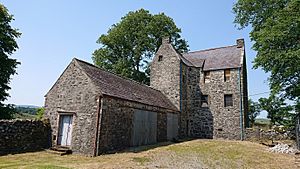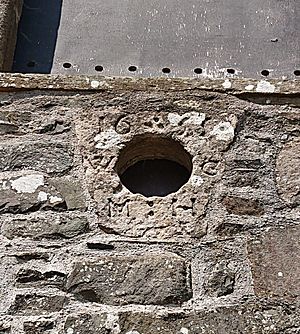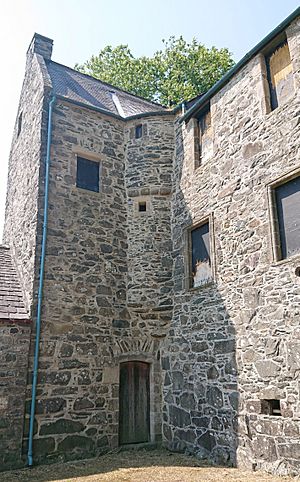Earlstoun Castle facts for kids
Quick facts for kids Earlstoun Castle |
|
|---|---|

Earlstoun Castle, viewed from the south-east
|
|
| Type | Tower house |
| Location | Near St John's Town of Dalry, Dumfries and Galloway |
| Designated | 1937 |
| Reference no. | SM1118 |
| Lua error in Module:Location_map at line 420: attempt to index field 'wikibase' (a nil value). | |
Earlstoun Castle, also known as Earlston Castle, is an old, ruined tower house in Scotland. It's located near St John's Town of Dalry in Dumfries and Galloway. This castle was built a long time ago, in the late 1500s.
For many years, Earlstoun Castle was home to the Gordon family. A famous member of this family was William Gordon of Earlston, who died at the battle of Bothwell Bridge. What makes this castle special is that it doesn't have many of the usual defenses you'd expect for a building from its time. It has no gun loops (small openings for guns), no parapet (a protective wall on the roof), and no corner turrets. Plus, it sits in an open field with no natural protection like hills or rivers.
The castle was named a "scheduled monument" in 1937. This means it's a very important historical site that needs to be protected. It was also a "Category A listed building" for a while, but that status was removed in 2017. It still remains a scheduled monument today.
Contents
Exploring Earlstoun Castle
Earlstoun Castle is found in the countryside, about 3 kilometers (2 miles) north of St John's Town of Dalry. It's a special type of castle called an "L-plan tower house." This means it's shaped like the letter 'L' when you look down from above.
The castle has three main floors with an attic on top. It's mostly built from a type of stone called greywacke rubble, with nicer sandstone used for details. The roof is made of slate. Originally, the castle would have been covered in a rough plaster called harling, but now you can see the stone walls.
As mentioned, this castle is quite unusual because it lacks many defenses. Most tower houses from its time had features like gun loops (small holes to shoot through), a parapet (a low wall on the roof for protection), and corner turrets (small towers at the corners). Earlstoun Castle doesn't have these. Also, it's built on open ground, which means it didn't have natural protection like cliffs or rivers. Today, a small farm building from the 1800s is attached to one side of the tower.
The main entrance to the castle is in the corner where the two parts of the 'L' meet. Above the door, there's a corbelled-out stair turret. This is a small tower that sticks out, supported by stone brackets called corbels, and it holds a spiral staircase.
When you enter, you step into a small lobby. From here, you can get to two storage rooms on the ground floor. These rooms have special arched ceilings called barrel vaults. The lobby also leads to the turnpike stair, which is a spiral staircase that takes you up to the higher floors.
On the first floor, there's a large hall that runs the whole length of the main part of the castle. This hall has big windows. You can still see some of its fancy Renaissance style wood panels and decorative cornicing (molding along the top of the walls). There's also a fireplace with decorative pillars called Ionic pilasters in one of the end walls. Sadly, all these beautiful features are now quite damaged.
The second floor of the main part of the castle was divided into two rooms. Each room had its own fireplace, large windows, and wood panels from the 1600s. There was also a small room with a fireplace and window in the stair wing. Above this room was a garret, which is like an attic space. The floors in these two upper rooms are now gone.
A Look Back: History of Earlstoun Castle
The land where Earlstoun Castle stands was bought by Sir John Sinclair around 1472. Records show that David Sinclair and his son John lived there in 1536. David passed away shortly after that. The castle we see today was likely built by John Sinclair (who was sadly murdered around 1583) or by his son, also named John.
In 1601, the land passed to the Gordon family, and John Gordon of Earlstoun moved into the castle.
The castle had some updates in the mid-1600s. A two-story addition was built onto one side. This addition had a stone carved with the date 1655 and the initials WG/MH. These initials stood for William Gordon of Earlston and his wife, Mary Hope. Around this time, the windows on the first floor were made larger, and the beautiful Renaissance-style wood panels were added to the great hall. The fireplaces and the way some rooms were arranged were also changed.
After William Gordon died at the Battle of Bothwell Bridge in 1679, soldiers were stationed at the castle. They were there to keep watch over the Covenanters, a group of Scottish Presbyterians.
The Gordon family sold the estate in the 1740s. After they left, the castle started to fall apart. In 1845, a report said that "With some repair it might be made habitable," meaning it could be lived in again if fixed. Later, in the late 1800s, two people named MacGibbon and Ross looked at the castle. They were sad to see how much it had decayed. They wrote that people who were born in the house and were still alive remembered it being in perfect condition not long before.
At that time, parts of the 1655 addition were still standing, including the datestone. But they had no roof, and most of their walls were gone. This addition was completely removed around 1950, but the datestone was saved and put into the eastern wall of the main castle building.
Earlstoun Castle became a scheduled monument in 1937. In 1978, some of the floors inside had collapsed, which made the walls unstable. The owners at the time tried to make the building safe again. In 2017, its status as a listed building was removed to avoid having two different types of protection, but it is still a very important scheduled monument.
Earlstoun Castle in Books
The story of the Gordons of Earlstoun is told in a novel by S.R. Crockett. His 1895 book, Men of the Moss Hags, was first published in parts in a magazine called Good Words. Later, it came out as a full novel by Isbister and became very popular around the world.
See also
- Scottish castles
- Tower houses in Britain and Ireland
Sources




